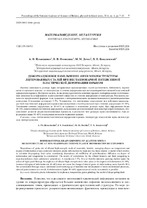Деформационное измельчение зерен микроструктуры легированных сталей при нестационарной интенсивной пластической деформации взрывом

Date
2016Publisher
Another Title
Deformational grain grinding of alloyed steels microstructure at non-stationary intense plastic deformation by explosion
Bibliographic entry
Деформационное измельчение зерен микроструктуры легированных сталей при нестационарной интенсивной пластической деформации взрывом = Deformational grain grinding of alloyed steels microstructure at non-stationary intense plastic deformation by explosion / А. Ф. Ильющенко [и др.] // Весцi Нацыянальнай акадэмii навук Беларусi. Серыя фiзiка-тэхнiчных навук. – 2016. – № 4. – С. 7-15.
Abstract
В статье изучена зависимость размера зерна легированных высокопрочных сталей аустенитного, бейнитного, мартенситно-стареющего классов от температуры и степени деформации при нестационарной интенсивной пластической деформации взрывом. Построена модель, позволяющая рассчитать величину предела диспергирования и учитывающая зависимость коэффициента зернограничной диффузии от степени деформации и температуры.
Abstract in another language
Dependence of grain size of alloyed high-strength steels of austenitic, bainitic, maraging classes on temperature and degree of deformation at non-stationary intensive plastic deformation by explosion has been studied. A model which enables to calculate dispergating limit value considering dependence of coefficient of grain-boundary diffusion on degree of deformation and temperature is constructed. The results of calculations by the offered formula and their comparing to experimental data show satisfactory coincidence. A rejection is 3–5%. It is set that the intensive growing shallow under the action of high-speed flowage the explosion of alloyed high-strength steels takes place at the degrees of deformation 20–30%. Increase of degree of deformation to 30–40% does not cause the change of size of grain. At deformations more than 40–50% the accumulated flowage causes additional local warming-up of material and development of recrystallizational processes, sizes of grain increase as a result. At deformations higher 50–60% appearances of cracks in materials is possible.
